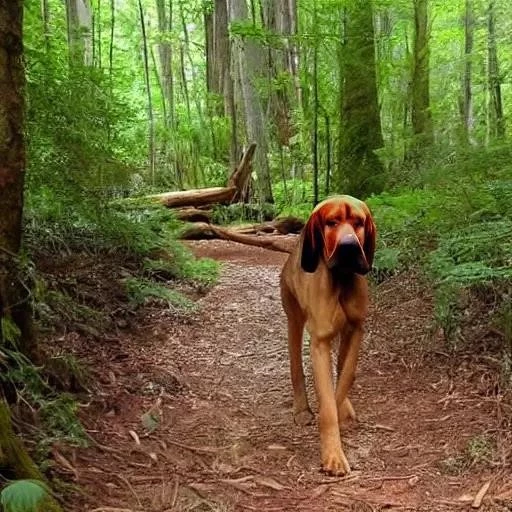
For centuries, the Bloodhound has been revered, almost mythologized, for its unparalleled olfactory prowess, a living, breathing testament to nature’s most sophisticated tracking system. This iconic breed, with its deeply wrinkled brow and melancholic eyes, typically conjures images of tireless pursuit through dense forests, diligently following a lost person’s trail. However, a fascinating shift is occurring in the perception of these magnificent canines. Increasingly, outdoor enthusiasts and adventurous dog owners are asking a pivotal question: could the Bloodhound, beyond its legendary tracking duties, actually be an incredibly effective and surprisingly ideal companion for long, challenging hikes?
The answer, for many, is a resounding and enthusiastic “yes,” albeit with crucial caveats and a deep understanding of the breed’s unique characteristics. Far from being merely a nose-on-legs, Bloodhounds possess an innate athleticism and an extraordinary capacity for endurance, qualities often overshadowed by their famous scenting ability. Their sturdy build, coupled with a calm and surprisingly amiable temperament, positions them as potential trailblazers, capable of transforming a simple walk into an exploratory odyssey. By integrating insights from experienced handlers and veterinary professionals, we can unravel the true potential of these remarkable dogs as steadfast hiking partners, charting a course for a new era of canine companionship on the trails.
| Attribute | Details | Relevance to Hiking |
|---|---|---|
| Breed Origin & Purpose | Ancient European origins, primarily Belgium and France. Bred specifically for tracking large game and, later, human scent. | Inherently possess incredible stamina and determination, vital for long treks. |
| Key Physical Traits | Large, muscular build (50-70 kg), loose skin, long pendulous ears, deep-set eyes. Known for their powerful scenting ability. | Strong physique for navigating varied terrains. Loose skin protects against brush. Scenting can be an asset or distraction. |
| Temperament | Generally gentle, affectionate, placid, and tolerant. Can be stubborn and independent, driven by scent. Excellent with children. | Calm demeanor makes them pleasant companions. Stubbornness requires consistent training and patience on the trail. |
| Stamina & Endurance | Exceptional. Bred to track for hours, sometimes days, over vast distances without tiring. | One of their greatest assets for hiking, capable of covering many miles. |
| Scent Drive | Dominant trait. Once on a scent, they are singularly focused and can become oblivious to commands or surroundings. | Requires constant vigilance and a secure leash. Can lead to unique trail discoveries but also potential danger if off-leash. |
| Heat Tolerance | Moderate to low. Their large size, dark coats (for some), and brachycephalic tendencies (though less severe than true brachycephalics) make them susceptible to overheating. | Hiking in hot weather must be avoided. Hydration and cool-weather trails are essential. |
| Training Needs | Requires consistent, positive reinforcement training from an early age. Leash training is paramount due to their strength and scent drive. | Well-trained Bloodhounds are safer and more enjoyable hiking partners. Recall is difficult once on a scent. |
| Health Considerations | Prone to bloat, hip/elbow dysplasia, ear infections, and eye issues. | Hikers must be aware of these risks and carry a first-aid kit. Avoid high-impact activities on young dogs. |
| Official Breed Reference | American Kennel Club ⸺ Bloodhound | For comprehensive breed information and standards. |
The Bloodhound’s profound physical capabilities are undeniable. Possessing an unmatched stamina, these dogs were quite literally bred to work for extended periods, following complex scent trails across varied and often challenging landscapes. This inherent drive translates remarkably well to the demands of a long hike. Unlike many breeds that might tire after a few miles, a well-conditioned Bloodhound often seems to gain energy as the journey progresses, their powerful legs effortlessly covering ground. Their heavy bone structure provides a stable base, making them surprisingly agile even on uneven terrain, a critical advantage when navigating rocky paths or steep inclines.
However, partnering with a Bloodhound on the trail demands a comprehensive understanding of their unique behavioral blueprint, particularly their legendary nose. As Dr. Emily Thorne, a renowned canine behaviorist, eloquently puts it, “A Bloodhound’s brain is perpetually processing a symphony of scents. When they lock onto a compelling aroma, it’s like an irresistible gravitational pull, overriding all other stimuli.” This unwavering focus means off-leash hiking is largely ill-advised, regardless of how well-trained the dog may seem. A robust, comfortable harness and a sturdy leash are non-negotiable tools for any Bloodhound hiker, acting as a vital tether to prevent an unscheduled and potentially dangerous solo expedition.
Moreover, the Bloodhound’s physical attributes, while largely beneficial, also present specific considerations. Their deep chests make them susceptible to bloat, a life-threatening condition requiring immediate veterinary attention. Owners must be diligent about feeding schedules and avoiding strenuous activity directly before or after meals. Their long, pendulous ears, while contributing to their iconic look, are prone to infections, necessitating regular cleaning, especially after dusty or wet hikes. Furthermore, their somewhat looser skin, while offering protection from thorns and brush, can also trap moisture, leading to skin irritations if not properly dried and cared for.
Despite these considerations, the rewards of hiking with a Bloodhound are immeasurable. Their calm and affectionate nature makes them wonderfully engaging companions, and their presence transforms a solitary trek into a shared adventure. Imagine walking through an ancient forest, observing your Bloodhound meticulously deciphering the earth’s fragrant tapestry, uncovering hidden wildlife trails or the faint scent of a deer that passed hours ago. This shared experience deepens the bond between dog and owner, forging a partnership built on mutual respect and a shared love for the great outdoors. With proper training, diligent care, and an appreciation for their extraordinary instincts, Bloodhounds are not just capable hiking dogs; they are truly exceptional, offering a profound and uniquely enriching experience that redefines the very essence of canine companionship on the trail.
